Is Selling on Amazon FBA Still Worth It in 2025?
Download Amazon Seller Guide
This guide will help you get started, understand the basics of Amazon selling, and explain in simple words how it all works.

Amazon FBA has been a popular choice for sellers looking to tap into the e-commerce giant's vast customer base. It offers a convenient service for sellers simplifying their logistics.
However, the platform has evolved significantly over the years. FBA fees are growing, and the competition is becoming more and more tough. Therefore, you must carefully balance your cost and profit and decide, case by case, whether FBA works well for each product.
This post explores whether Amazon FBA remains a profitable choice in 2025 and how to decide if it's a good fit for your business.
Is Amazon FBA still worth it in 2025?
.avif)
Amazon FBA, or Fulfillment by Amazon, is a service provided by Amazon that helps third-party sellers manage their order fulfillment and logistics.
Using FBA allows sellers to benefit from Amazon's fast shipping options, including Prime eligibility, which can attract more customers. It also frees sellers from the complexities of storage, shipping, and customer service, allowing them to focus on other aspects of their business, such as product sourcing and inventory management.
Amazon FBA offers a convenient way for sellers to outsource logistics and tap into Amazon's efficient delivery network, and grow their sales. However, it requires careful consideration of the associated costs.
Factors to consider whether Amazon FBA is worth it for you

FBA is a most popular choice for Amazon sellers. According to Jungle Scout research, 82% of sellers use FBA (yet the figure decreased by 3% since 2023). However, its worth in 2025 depends on several factors specific to your business model and individual product type.
- Costs
FBA fees, including storage and fulfillment costs, can be substantial. In 2025, sellers need to carefully evaluate these costs against their profit margins. The cost-effectiveness of FBA largely depends on the volume and turnover of your products.
- Competition
The level of competition on Amazon has continued to grow. Sellers need to differentiate their products, whether through quality, branding, or unique selling points, to stand out in a crowded marketplace.
- Simplified fulfillment
FBA handles storage, packing, and shipping, which can save time and simplify logistics for sellers. This convenience can be particularly valuable for businesses looking to scale without dealing with inventory fulfillment.
- Customer reach
Amazon’s vast customer base and the trust associated with the Amazon Prime badge can drive higher sales volumes for FBA products. This access to a large, engaged audience can offset higher fees, especially for new or growing businesses.
- Product type and demand
The nature of your products—size, weight, shelf-life, and demand—can significantly influence the benefits of using FBA. For instance, products that are lightweight and high in demand often see better cost-efficiency with FBA.
How Does Amazon FBA Work?
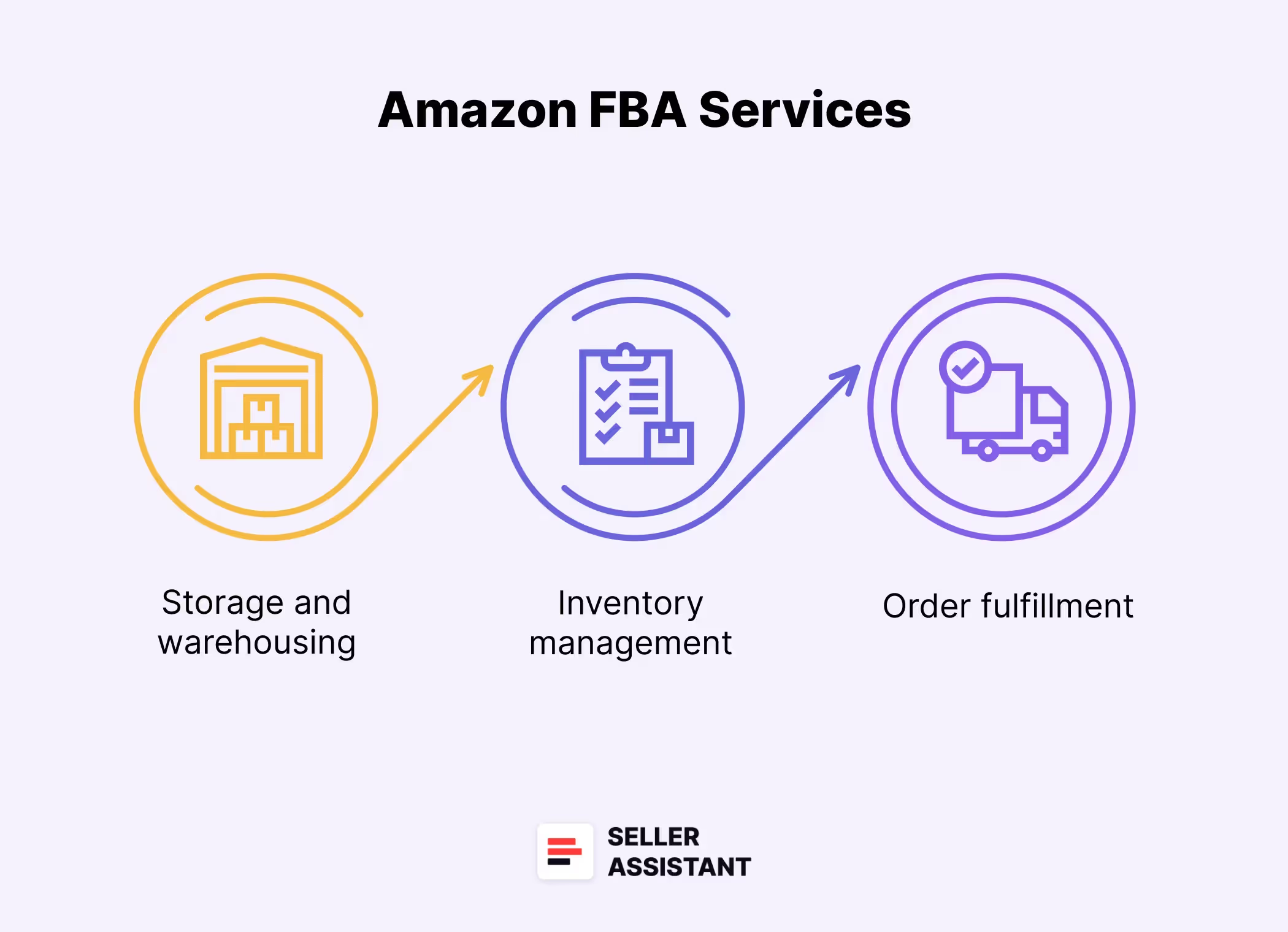
Amazon FBA is a service provided by Amazon where it fulfills orders to the customers on behalf of third-party sellers for a fee. Here's a breakdown of how it works.
- Storage and warehousing
Sellers send their products to Amazon's warehouses, where they are stored until a customer places an order.
- Order fulfillment
When an order is placed, Amazon picks, packs, and ships the product to the customer. This includes handling the entire logistics process, from packaging to delivery.
- Customer service and returns
Amazon handles customer service on behalf of the sellers, including returns and refunds, which simplifies the process for sellers and provides a consistent experience for customers.
- Amazon Prime eligibility
Products fulfilled by Amazon are eligible for Amazon Prime, which can increase visibility and sales, as Prime members often prefer products that offer free and fast shipping.
- Inventory management
Amazon also offers tools for managing inventory levels, tracking shipments, and forecasting demand, helping sellers optimize their stock levels and reduce storage costs.
Key Things to Remember about FBA
Amazon FBA can be a great option for sellers, but it's essential to understand its intricacies. When considering (FBA, there are several important aspects to keep in mind.
Fees and costs
- Fulfillment fees
.avif)
These cover the picking, packing, and shipping of your products. Fees vary based on product size and weight.
- Storage fees
.avif)
Amazon charges for storing your products in their warehouses, with rates typically higher for larger or slower-moving items. There are also additional aged inventory storage fees for items that remain in the warehouse for an extended period.
- Other costs
Additional fees can apply for optional services such as inventory removal, labeling, and repackaging.
Inventory management
- Restocking
Though Amazon takes care of order fulfillment, you’re still responsible for replenishing inventory. Keep track of your inventory levels and plan restocking to avoid running out of stock, which can negatively impact your sales. However, don’t send too much inventory to Amazon to avoid unnecessary storage fees. Use the FBA Inventory report to get recommendations on which products to restock, along with suggested quantities and shipping dates.
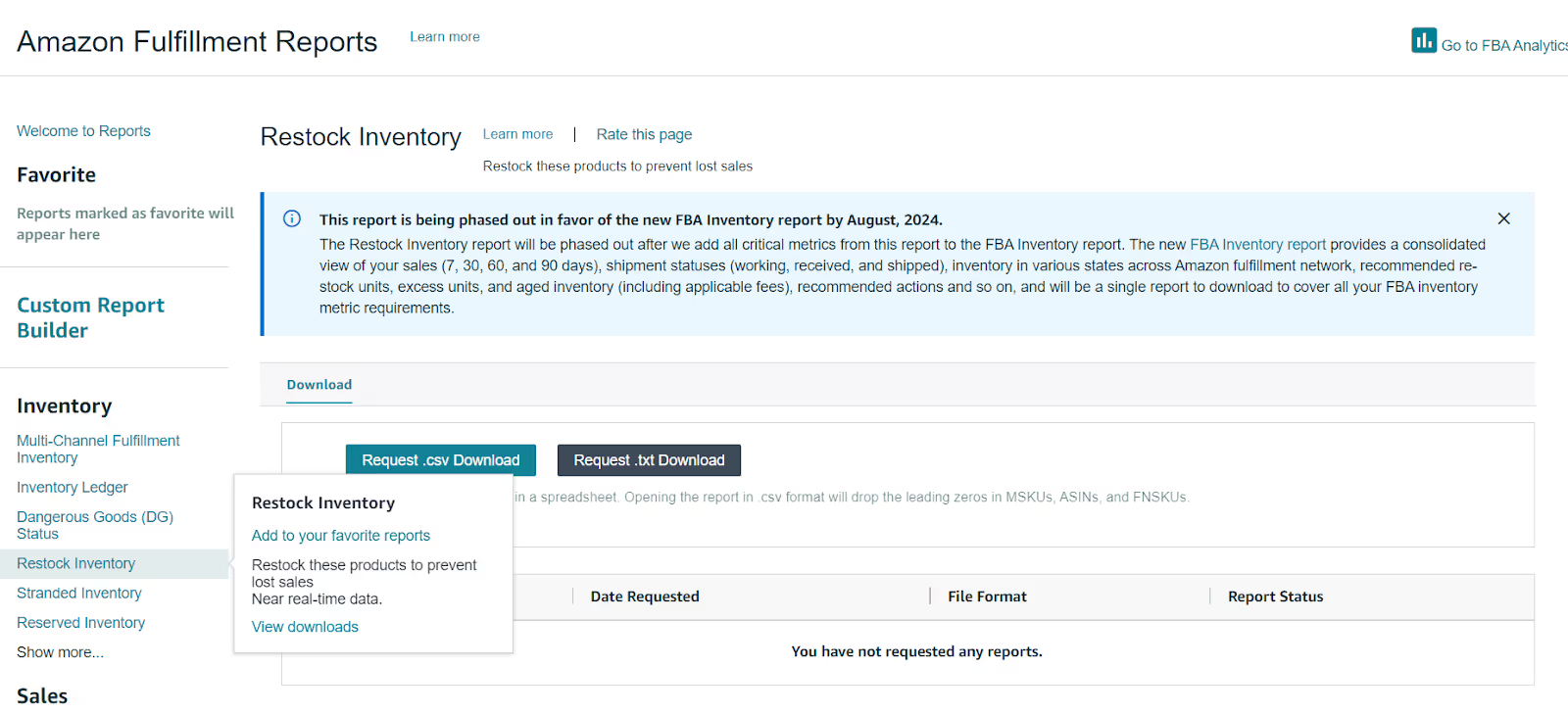
- Inventory health
Monitor your inventory health to avoid overstocking, which can lead to increased storage fees, or understocking, which can result in missed sales opportunities.
- Storage limits
Amazon may impose storage limits based on your inventory performance, so it’s crucial to manage your stock efficiently to avoid excess fees or restrictions. FBA capacity limits determine the amount of inventory space Amazon allocates to sellers in its fulfillment centers each month.
You can view your capacity limits and usage in the Capacity Monitor at the bottom of the FBA dashboard.
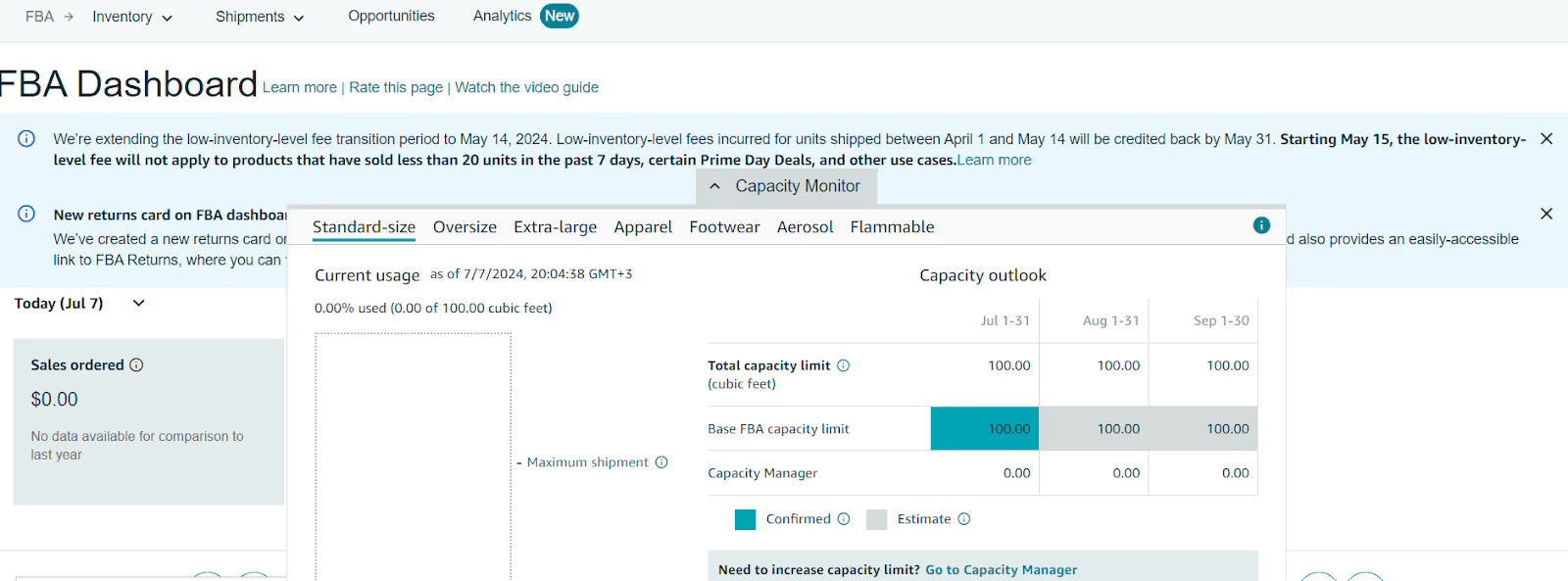
Customer service
- Returns and refunds
Amazon manages returns and refunds, which can simplify the process for sellers and provide a consistent experience for customers. However, Amazon manages returns and refunds on behalf of sellers automatically, and you don’t have any influence over this process.
- Customer support
Amazon provides customer service for FBA orders, handling inquiries and issues related to shipping, delivery, and returns.
Product compliance
.avif)
- Product guidelines
Ensure your products comply with Amazon’s guidelines and including those related to safety, labeling, and restricted items. Make sure you can fulfill products with FBA before you purchase them.
- FBA inventory prep requirements
Follow Amazon’s requirements for inventory preparation, including labeling, packaging, and shipping to fulfillment centers. Adhering to Amazon's packaging requirements is crucial, as failure to do so can result in additional charges for repackaging your products.
Pros and cons of Amazon FBA
When evaluating Amazon FBA for your business, it's crucial to consider both the benefits and drawbacks. This assessment will help determine if FBA aligns with your business needs and goals.
Pros of Amazon FBA
.avif)
- Simplified fulfillment
Amazon FBA takes over logistics, allowing you to focus on product sourcing and business growth. This can be particularly beneficial for new sellers or those with limited resources or wholesale sellers who sell bulk inventory.
- Increased Buy Box opportunities
FBA sellers are often favored for the Featured Offer (Buy Box), which is the "Add to Cart" button prominently displayed on product pages. This can lead to increased visibility and higher sales.
- Fast and free shipping
Products enrolled in FBA are eligible for Amazon Prime’s free same-day or one-day shipping, attracting customers who prioritize quick and free delivery.
Cons of Amazon FBA
.avif)
- FBA Fees
FBA incurs various fees, such as storage, fulfillment, and other associated costs, which can impact profit margins. It's important to calculate these fees carefully to ensure profitability.
- Aged inventory fees
Products stored in Amazon warehouses for more than 180 days incur additional storage fees, which can be costly for slow-moving items. Sellers with such products might consider Fulfillment by Merchant (FBM) as an alternative.
- Strict preparation requirements
Amazon has detailed guidelines for inventory preparation and labeling. Non-compliance can result in additional costs for repackaging or delays in delivery.
Does FBA Work for Me?
If you're debating whether to go with FBA or Fulfillment by Merchant (FBM), when you sell on Amazon but fulfill inventory yourself, consider these factors to find the best match for your business needs.
.avif)
When to opt for FBA
- High sales volumes
FBA is well-suited for businesses with a large volume of sales. Amazon's fulfillment centers are equipped to handle significant order quantities efficiently, allowing you to concentrate on scaling your business.
- Limited fulfillment experience
If you lack experience in fulfillment, navigating Amazon’s complex packaging standards can be daunting. FBA handles packaging and shipping, helping you avoid potential delays and additional costs due to improper preparation.
- No Storage Space
If you don't have enough space to store your inventory, FBA offers storage solutions at Amazon’s fulfillment centers, although storage fees will be charged.
- Standard-size products
FBA is most cost-effective for items that fall within Amazon’s standard size categories. Larger or heavier items may incur higher fulfillment fees.
When to opt for FBM
- Slow-moving inventory
For products that sell slowly, FBM can be a better choice as it helps you avoid Amazon’s long-term storage fees.
- Logistics expertise
If you have experience in logistics, including packaging, shipping, and customer service, managing fulfillment yourself through FBM can reduce costs.
- Existing shipping partnerships
If you already have a trusted shipping partner, FBM allows you to use their services, potentially negotiating better rates than those offered by FBA.
- Specialty or custom items
For handmade, unique, or non-standard size products that require special handling, FBM provides more flexibility in packaging and potentially lower costs compared to Amazon’s standard fulfillment options.
How to Know if Amazon FBA is Worth It?
Determining if Amazon FBA is worth it for your business involves careful consideration of specific product metrics and your business goals.
You can use seller tools to quickly estimate your product data and decide if FBA is a right choice. Seller Assistant is a comprehensive product-sourcing software that helps Amazon sellers quickly find high-profit deals. It combines two extensions: Seller Assistant Browser Extension, and IP-Alert Chrome Extension by Seller Assistant, Amazon seller tools: Bulk Restrictions Checker and UPC/EAN to ASIN converter, and features: Side Panel View, FBM&FBA Profit Calculator, Quick View, Seller Spy, Stock Checker, IP Alert, and Restrictions Checker.
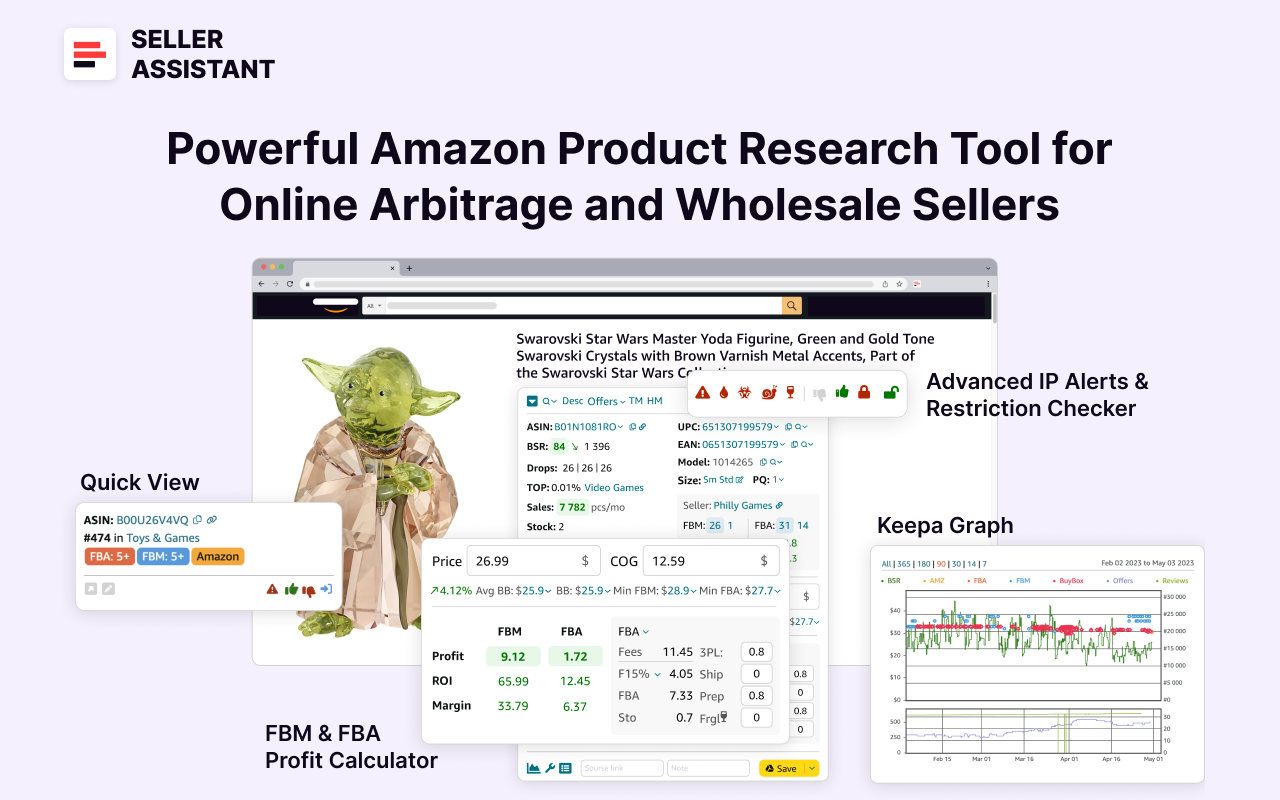
Seller Assistant shows all essential product data on Amazon search, product, and inventory pages, and on any website to help you find high-margin deals. By using this FBA and FBM product sourcing software, you can easily identify products that have the potential to be sold well on Amazon.
Do product research
- Profitability
Assessing profitability involves more than just looking at the selling price of your product. Calculate the total costs, including product costs, FBA fees, shipping and prep expenses, and any other associated costs. This will help you determine your profit margins and ensure that they are sufficient to sustain your business and provide a reasonable return on investment (ROI).
Use Seller Assistant to effortlessly review this data on the Amazon product pages or even on your supplier website. It automatically shows you profit, ROI, and profit margin figures, and all FBA fees. To calculate profitability, simply enter Cost of Goods Sold (product cost at the supplier) in the ‘COG’ field, and add shipping cost and prep (if you use it) in the ‘Ship’ and ‘Prep’ fields.
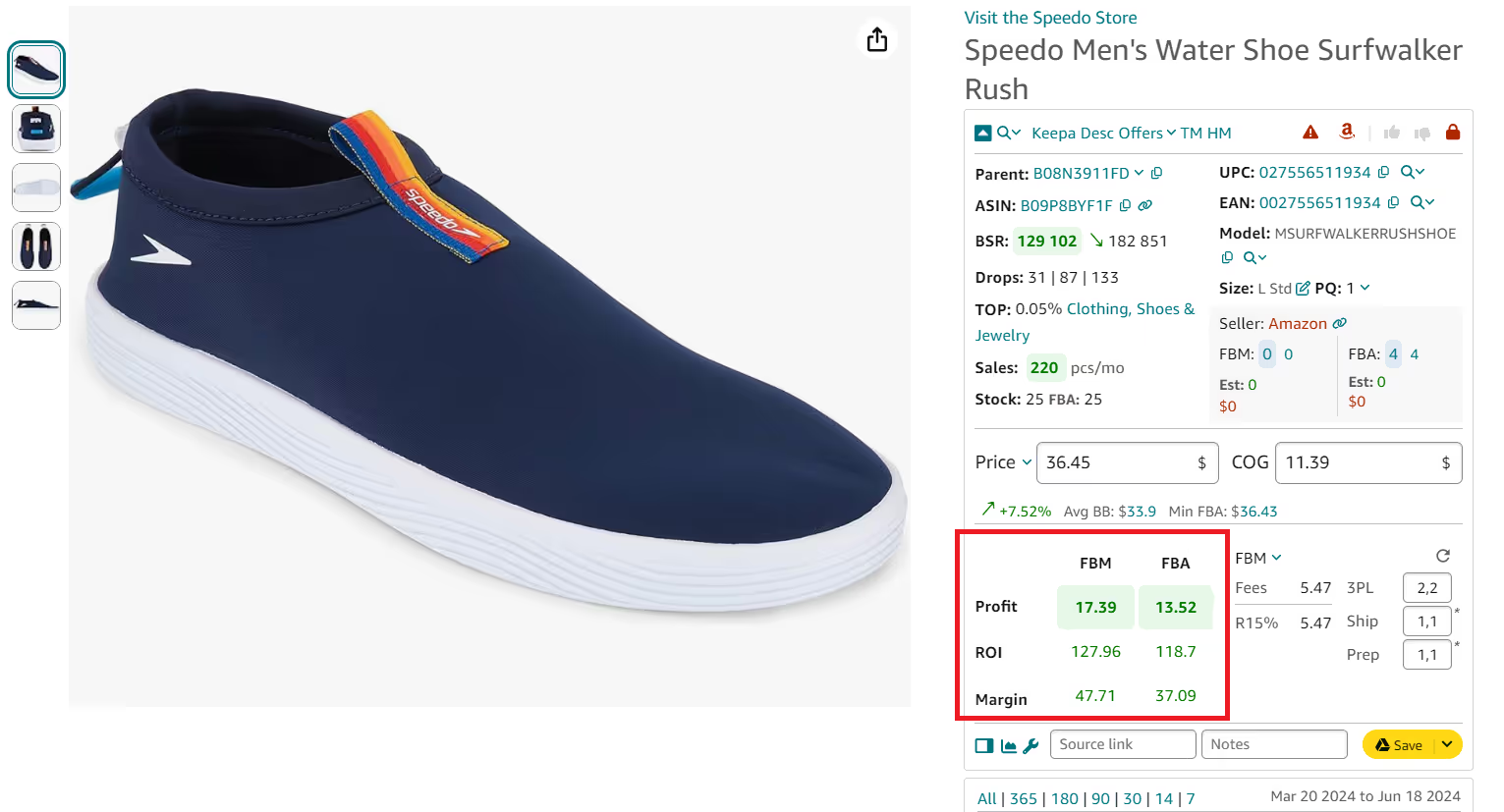
- Demand
Understanding product demand is essential for predicting sales volume. Use product sourcing software to gauge demand levels for your chosen product categories. This analysis should include seasonality, market saturation, and consumer trends, helping you select products that are more likely to sell quickly and consistently. If your product is a slow-mover, better go for FBM to avoid high storage fees.
Seller Assistant shows product’s sales velocity as a percentage in the Top field. If the Top equals 0.5% or less, the product sells well. If the Top equals 1% or more, a product is a slow-mover. You can also see estimated product sales based on BSR in the Sales field.
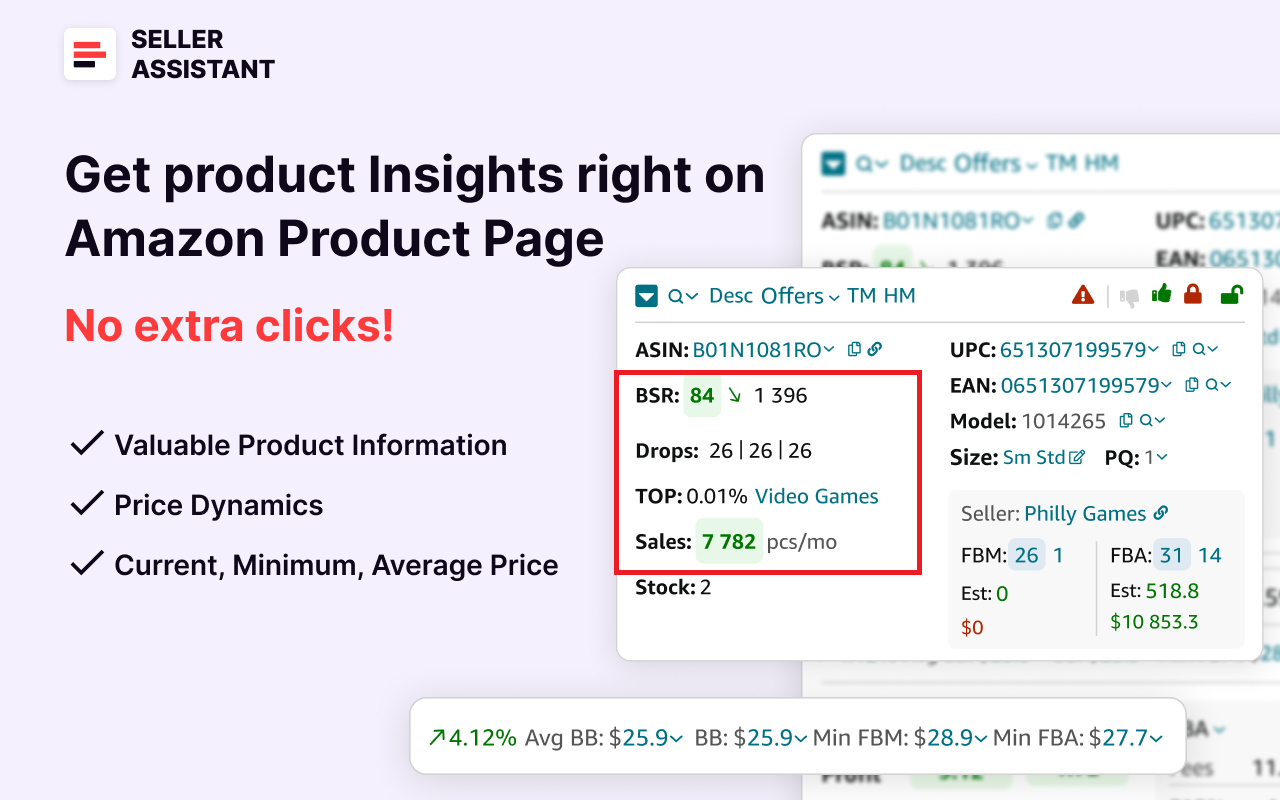
- Product weight and size
Consider the size and weight of your products, as these factors significantly impact FBA fees. Larger and heavier items incur higher storage and fulfillment fees, which can reduce profit margins.
Seller Assistant shows size and package quantity on the Amazon product pages. Size is a packaged product size tier based on its weight, dimensions, and dimensional weight. Package Quantity shows the count of items in the package. You can also see a red box icon if a product is heavy and bulky.

- Product flags and alerts
The product you want to sell with FBA may have hidden risks or challenges you may not see at the first glance. For instance, a product may be meltable and you will not be able to sell it through FBA all the year round, or it can be fragile and you will need to pay extra for packaging. You must be aware of that and account for all costs. In some cases, you may prefer to choose FBM.
Seller Assistant’s Alerts and Flags feature warns you with a specific icon if a product has one or several flags.
Seller Assistant flags
- Red box icon for oversized products;
- Red glass icon for fragile products;
- Red drop icon for meltable products;
- Red hazmat icon for the Hazmat (Dangerous goods) category;
- Red 18+ icon for adult products;
- Red GB icon for generic brand
- Red “A” icon (on the product pages) or Amazon on the orange background (on the search pages) if Amazon is a seller.

Consider your business goals
- Time commitment
While FBA can streamline logistics and free up time for product development and marketing, it's not a completely hands-off solution. You'll still need to manage inventory, prep and ship it to Amazon, and handle some aspects of customer service. You must compare that with FBM and if you don’t have many products, it may be cheaper to do fulfillment yourself.
- Scalability
FBA can support business growth by handling increased sales volumes, but you'll need to ensure that your inventory management and supply chain can scale accordingly. If you sell bulk products wholesale, in some cases, FBA can be a better choice.
- Business model type
Some business models, like dropshipping, typically do not use FBA. In dropshipping, sellers do not hold inventory but instead have products shipped directly from suppliers to customers. This model avoids the need for storage and handling, making FBA unnecessary..
Assess your financials
- Startup costs
Initial investment includes purchasing inventory, and shipping products to Amazon's warehouses. If you are tight on money and can’t afford to purchase inventory, but want to sell on Amazon, you can start with dropshipping, where you don’t deal with inventory but instead have products shipped directly from suppliers to customers. This model doesn’t use FBA. However, you must carefully study Amazon’s dropshipping policy.
- Ongoing fees
Familiarize yourself with Amazon's fee structure, including storage fees, fulfillment fees, and referral fees. These costs can add up and impact profitability, so they need to be carefully managed.
Seller Assistant’s FBM&FBA calculator shows all FBA fees on the Amazon product pages: total FBA fees, referral, fulfillment, storage, and Inbound placement service fees.
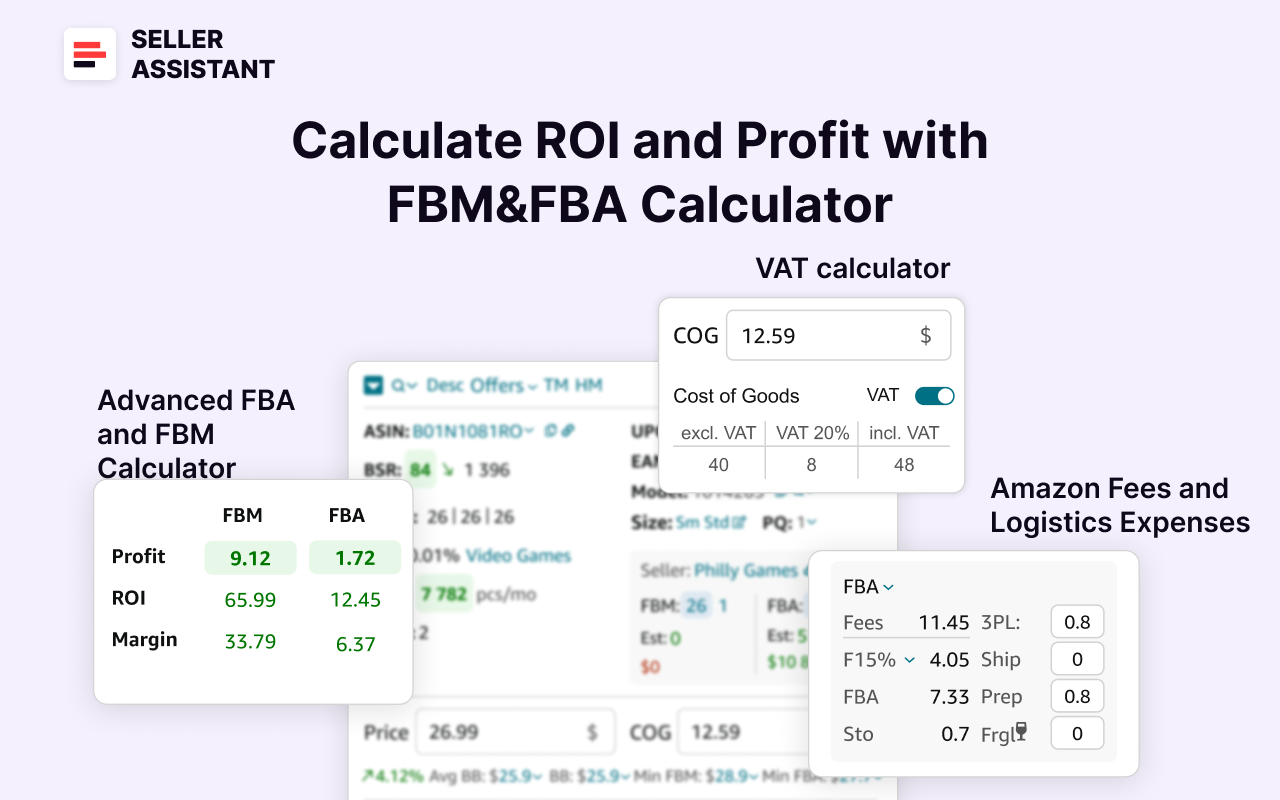
- Profit margin
After accounting for all expenses, ensure that your profit margin is sufficient to sustain your business. A good margin allows for reinvestment, growth, and cushion against unexpected costs.
With Seller Assistant, you can quickly view profit margin figures and decide if FBA leaves you with sufficient profit margin. To calculate profit margin, enter Cost of Goods Sold (product cost at the supplier) in the ‘COG’ field, and add shipping cost and prep (if you use it) in the ‘Ship’ and ‘Prep’ fields.
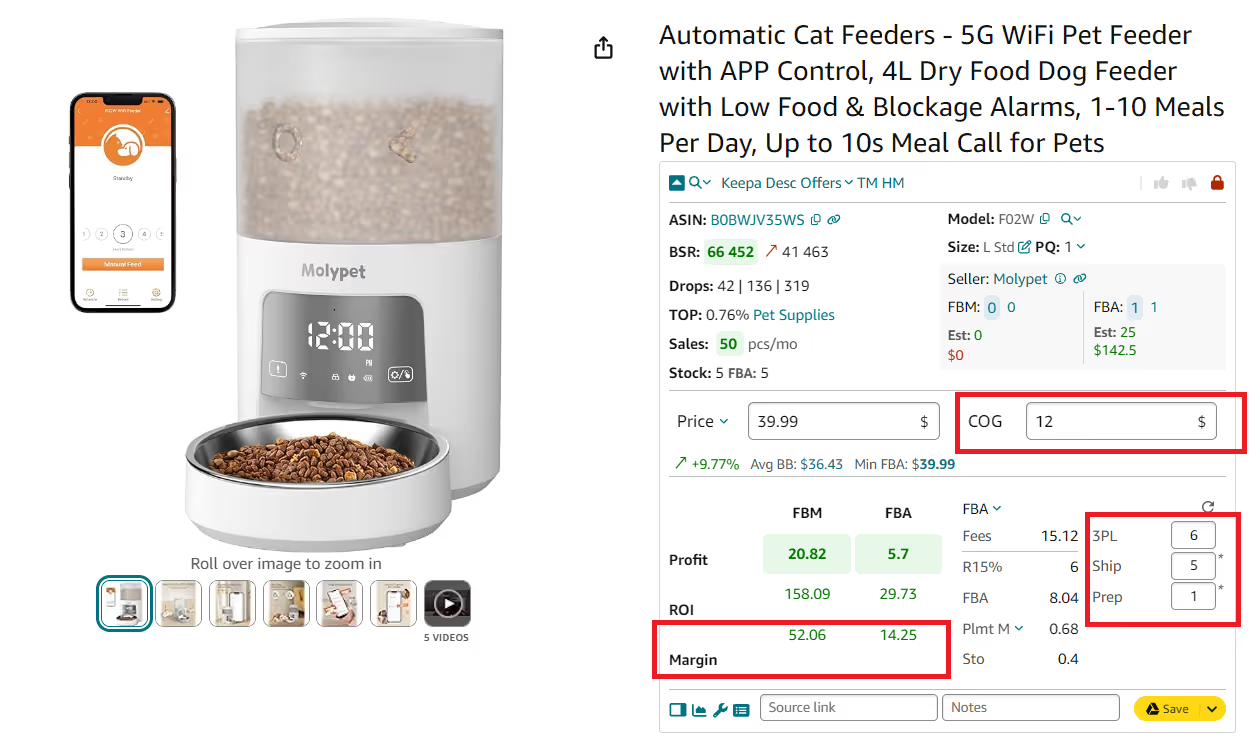
Is Amazon FBA profitable in 2025?
FBA continues to be profitable for many sellers in 2025 proven by the Jungle Scout’s figures below. However, the degree of profitability varies widely based on factors such as product selection, pricing strategies, and market competition.
Profit margins
A significant portion of Amazon sellers are achieving strong profit margins. Data indicates that 57% of sellers see profit margins exceeding 10%, demonstrating that a well-managed FBA business can be lucrative.
Furthermore, 28% of sellers are enjoying even higher profitability, with margins of at least 20%. This level of profitability is often reached by those who effectively manage costs and optimize their product listings to stand out in a competitive marketplace.
Lifetime profits
Looking at long-term success, 30% of Amazon sellers have achieved lifetime profits exceeding $50,000.
This figure highlights that while Amazon FBA offers substantial earnings potential, achieving such levels requires consistent product sourcing effort and strategic planning.
Monthly sales volumes
The range of monthly sales among Amazon sellers shows a diverse set of experiences. About 40% of sellers report monthly sales between $1,000 and $25,000, indicating a healthy turnover that can support a profitable business model if managed efficiently.
Additionally, 30% of sellers report monthly sales exceeding $5,000, showcasing a segment of the market that consistently generates significant revenue.
On the other hand, 31% of sellers report making less than $500 per month, which may reflect challenges such as high competition, pricing issues, or product visibility problems.
How Much Does It Cost to Start an Amazon FBA in 2025?
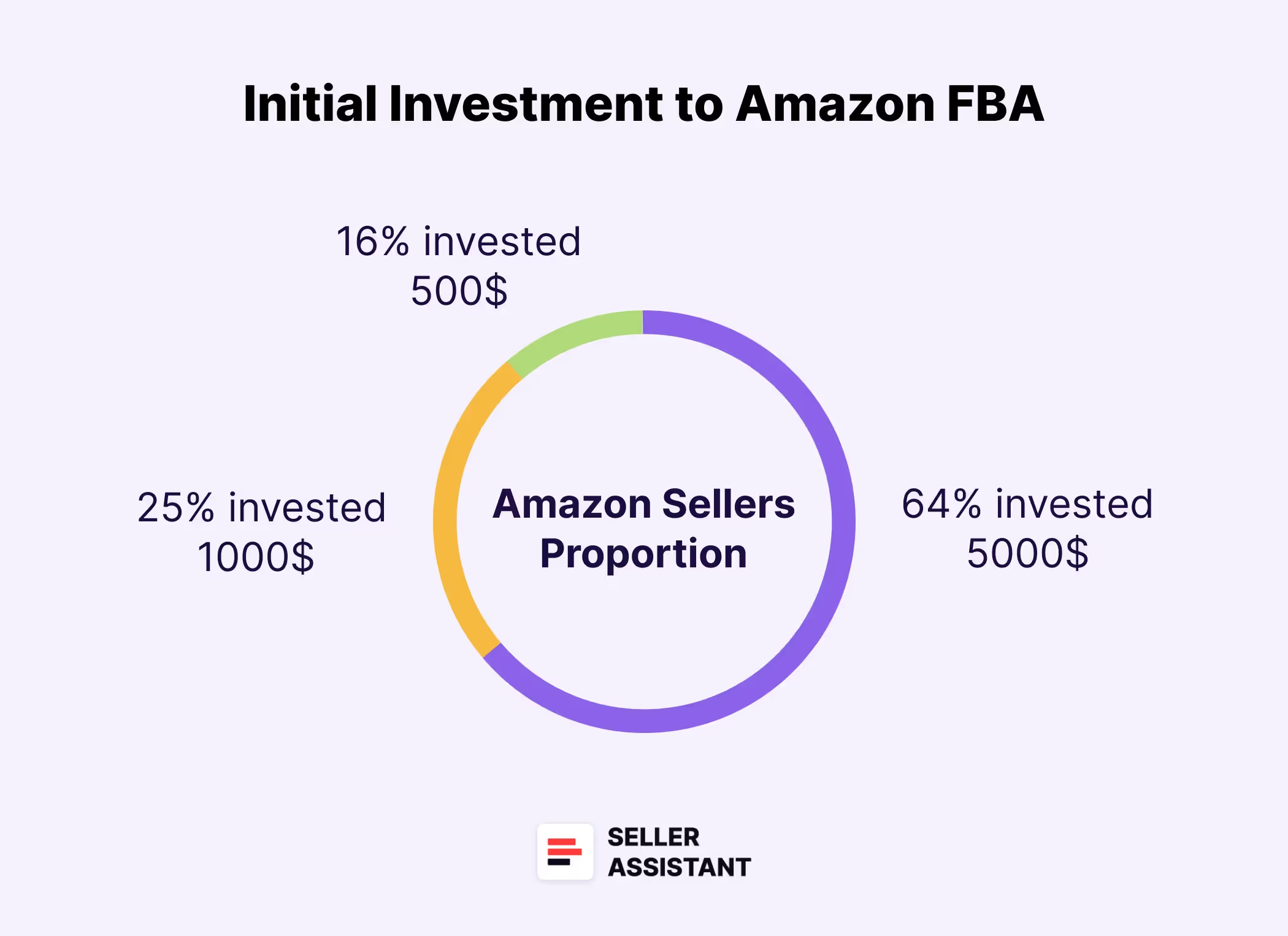
Starting an Amazon FBA business can be relatively affordable, though initial costs can vary widely depending on the scale and approach of the seller.
Initial investment
A majority of Amazon sellers (64%) started their business with an investment of approximately $5,000 or less. This figure highlights that launching a business on Amazon does not necessarily require a substantial upfront capital investment, making it accessible to a broad range of sellers.
Notably, a significant portion of these sellers, about 25%, started with an even smaller budget of less than $1,000. Impressively, 16% of sellers managed to launch their Amazon sales with under $500, demonstrating that entry into the FBA can be achieved with minimal financial outlay.
Time to profitability
The pathway to profitability on Amazon FBA can be relatively quick. More than a third (35%) of sellers report turning a profit within six months of starting their business. This rapid return on investment is particularly attractive for small to medium-sized sellers who are keen on seeing a quick turnaround.
For larger enterprise brands and retailers, the journey to profitability tends to be even faster. With more significant resources at their disposal, 77% of these larger players report becoming profitable in less than three months.
FAQ
Is selling on Amazon still profitable in 2025?
Yes, selling on Amazon can still be profitable in 2025, with many sellers achieving substantial profit margins. Success depends on effective product selection, competitive pricing, and efficient management of costs and logistics.
How long does it take to be successful in Amazon FBA?
Success in Amazon FBA can vary, but many sellers see profitability within 6 months, especially with effective product sourcing. Larger businesses with more resources often achieve profitability even faster, sometimes within 3 months.
Is Amazon FBA long term?
Yes, Amazon FBA can be a long-term business model, as it provides a scalable platform for growing sales and reaching a global market. However, sustained success requires continuous adaptation to market trends, competition, and Amazon's policies.
What is the success rate of Amazon FBA wholesale?
The success rate of Amazon FBA wholesale varies, but it generally depends on factors like product selection, supplier reliability, and market demand. While many sellers find success, profitability often requires effective sourcing strategies and ongoing market analysis to stay competitive.
Can you really make money doing Amazon FBA?
Yes, many sellers make money through Amazon FBA. 30% of Amazon sellers have achieved lifetime profits exceeding $50,000, according to Jungle Scout.
How much does an average Amazon FBA make?
On average, Amazon FBA sellers can make between $1,000 and $25,000 per month in sales. However, profitability varies widely based on factors like product selection, pricing strategies, and market competition.
Final Thoughts
In conclusion, selling on Amazon FBA in 2025 remains a profitable option for many sellers, provided they carefully assess the associated costs, market demand, and competition. While FBA offers significant advantages such as streamlined logistics and access to Amazon's vast customer base, success depends on effective product sourcing, inventory management, and maintaining consistent profitability.
Seller Assistant is the best product sourcing software for Amazon sellers that helps identify profitable products among thousands of potential deals. It also assists in quickly and reliably doing advanced product research.
Seller Assistant is a new-generation product sourcing software offering all the features you need to find the most profitable products to sell on Amazon. It includes Seller Spy, Side Panel View, FBM&FBA Profit Calculator, Quick View, ASIN Grabber, UPC/EAN to ASIN converter, Stock Checker, IP Alert, and Restrictions Checker, and other key product research features and provides value for money.
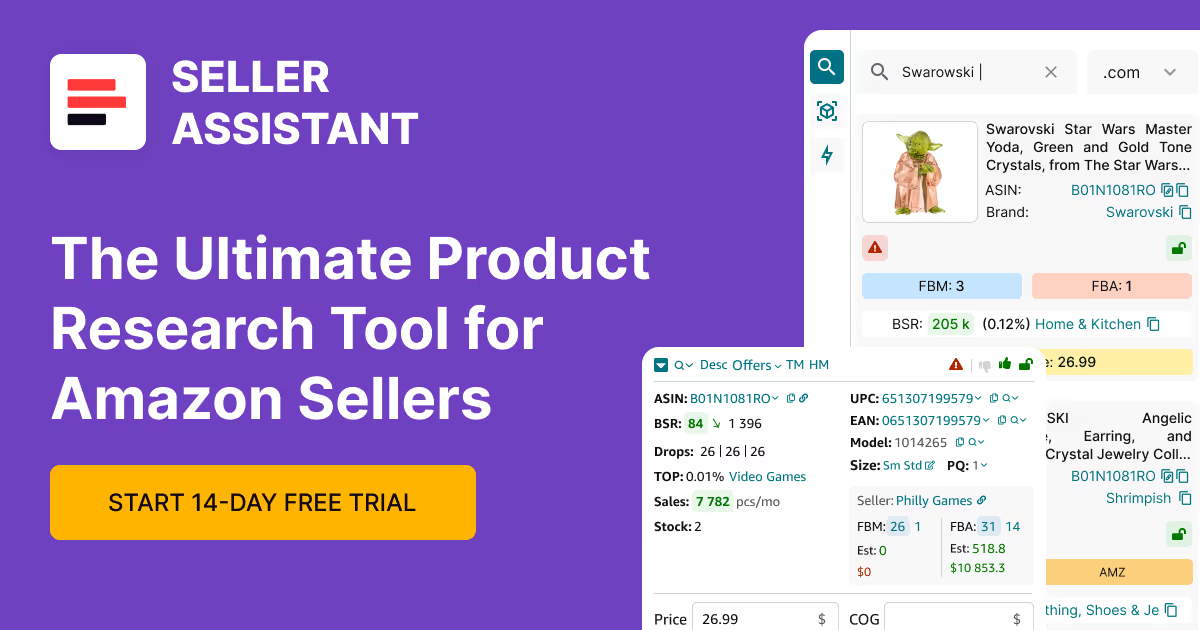
.svg)













